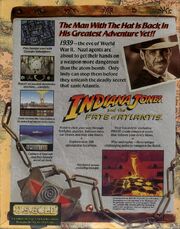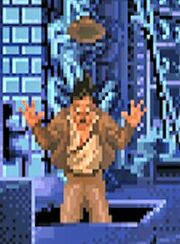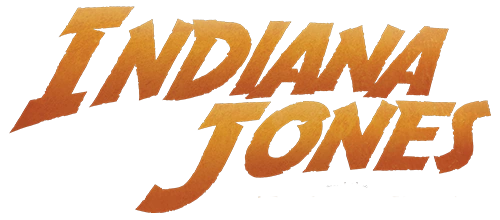
Back of Box
Indiana Jones and the Fate of Atlantis (also erroneously called Indiana Jones 4) is a graphical adventure game, originally released in 1992 and published by LucasArts. It was the seventh game to use the SCUMM adventure game engine. The game's plot was quite sophisticated, based on writings by Plato. Using the lead character from the well-known Indiana Jones film series it was based on an original story. A four issue Indiana Jones and the Fate of Atlantis comic series was produced in conjunction with Dark Horse Comics and published the year before the games release in 1991. Despite being the same basic plot, there were of course slight differences in the story.
Plot summary
Indy was asked by Marcus Brody and a certain Mr. Smith to find a particular strange idol from Barnett College's museum. Due to a stairway being closed for repairs, Indiana Jones had to swing through a roof window using his Bullwhip to search the junk and fakes of the museum's attic. As he looked at a a rather peculiar looking statue, he accidentally fell through a trap door that someone had left unlocked.

Indiana falls through the trap door
Recovering from his fall, Indy found himself in another part of the attic which housed textiles from the Shawmut Collection, and beadwork from the Phoenix Collection amongst other things. As he picked up a rope to climb through another open trap door, a large totem pole fell on him knocking him through it, into the college's library.
Searching the library, Indy came across some unfamiliar books on statues. Thinking they may aid in his search, he removed them from the bookshelf. Unfortunately, the shelf was unsecured and it fell over onto Indy (it really wasn't his day!!!) and knocked him through the obviously very thin floor and ceiling into the store room below.
In the store room, Indy found four cat figurines. As he examined them, one turned out to be a real Cat which hissed loudly startling Indy and sending him reeling backward. Indy lost his balance and slipped down the coal chute into the boiler room.
Indy searched the boiler room, and found a Horned statue in one of the lockers. This was the statue he had been looking for!
When Indy returns, inside the statue they find a small metal bead and Smith, to their surprise, steals the statue. It is revealed his real name is Klaus Kerner and he is an agent of the Third Reich and his next target is Sophia Hapgood.
Sophia Hapgood, an ex-colleague of Indy, now presents herself as a psychic, giving seminars about Atlantis and communicating with the Atlantean god-king Nur-ab-sal. Kerner was after her medallion, which she and Indy found in Iceland and which helped her communicate with Nur-ab-sal. A race between Jones and the Nazis to find the mythical lost continent of Atlantis begins, which may contain technology vital to the future of the world, since Kerner discovered that the metal bead found in the statue was Orichalcum, the legendary metal that would give extreme power to machines and create bombs. Kerner finds this out after bringing the bead and statue to his mad scientist boss, Dr. Hans Ubermann.
On some point, the team must find The Hermocrates, the lost dialogue of Plato discussing Atlantis further than his previous works (Timaeus and Critias). Indy visits places that are connected to the Atlantis literature, like a Mayan pyramid, the Azores, Thera and Crete, and the plot attempts to tie together many of the existing theories concerning Atlantis (which in reality are independent and don't necessarily co-exist).
The middle part of the game has three alternative paths. At the end, they all merge and Indy and Sophia meet again. Atlantis is found in the Aegean sea, and as expected, it is depicted in ruins but in a strange alien-like manner.
Appearances
Characters
- Indiana Jones
- Marcus Brody
- Sophia Hapgood
- Cat
- Mr. Smith
- Dr. Hans Ubermann
- Charles Sternhart
- Omar Al-Jabbar
- Trottier
- Nur-Ab-Sal
- Fritz
Artifacts
- Egyptian Statue of Horus
- Christopher Columbus' Chest
- Stone Carving of Shiva
- Masai Warrior Statue
- Funeral Urn
- Medieval Gargoyle
- Peculiar Statue
- Textiles from the Shawmut Collection
- Potlatch Indian Totem Pole
- Beadwork from the Phoenix Collection
- Crate of Unidentified Potsherds
- Arrowhead from the Shawmut Collection
- Siamese Cat Idol
- Fertility Idol of Bast
- Ancient Mesopotamian Cat God Figurine
- Tutenkhamen's Cat
- Horned Statue
Behind the scenes
Technical details
More innovative than the earlier Indiana Jones adventure game, Indiana Jones and the Last Crusade, Fate of Atlantis featured a nod to originality by including three differing paths to the completion of the game and many alternative ways to solve puzzles. The player who finishes all of the puzzles in all three paths and all of the alternative solutions, receives a full IQ (Indy Quotient) score. At one point in the game, during a dialogue sequence, the player chooses between three paths: The Wits path concentrates on puzzles, the Fists path is more dependent on fist fights (the game includes a rudimentary engine for such fights), and the Team path combines both elements and features Sophia Hapgood as a sidekick.
It is also significant for breaking with the LucasArts adventure game tradition of not allowing the player to die (though it was also possible to die at some points in Last Crusade and Zak McKracken and the Alien Mindbenders). After the player's death, a short "what happened next" plot summary and a score appear. To the player's advantage, the game conveniently alerts the player of impending danger so that he or she can play more cautiously.
The project was led by Hal Barwood; Barwood wrote the story and designed the game together with Noah Falstein. The music was composed by Michael Land, Clint Bajakian, and Peter McConnell, based heavily upon the works of John Williams.
The game was re-released on CD-ROM with a full voiceover soundtrack in 1993.
Trivia
- Game resource editing programs like ScummRev have revealed that there is an unused ('secret') room in the game code that didn't make it to the final version. This room is Sophia's bedroom, and lies next to her ransacked office. The programmers must have originally planned some more action in Sophia's apartment, but then thought that the presence of such a room and an additional sequence would not be vital to the gameplay. In the final version, all that takes place in Sophia's apartment is an extended dialogue in her office.
- In the 'secret' bedroom, some objects can be identified with ScummRev; this indicates that the programmers intended some puzzle to be solved by the player, apart from the office dialogue. In that bedroom, perhaps Sophia made her introduction as a playable character, so that the player had to guide her to, for example, find the orichalcum bead. One of the useable objects is labeled as Chuck the Plant, which is an inside joke at LucasArts and a nod to several previous LucasArts games.
- The adventure game was released simultaneously with Indiana Jones and The Fate of Atlantis: The Action Game, a remake loosely following the same storyline, and belonging to the arcade-adventure genre. The Action Game never enjoyed great popularity.
- There were unsubstantiated rumours that the Fate of Atlantis franchise (known as Indiana Jones 4) was the official precursor to a fourth movie.
- LucasArts had planned on developing this game for the Sega CD, but canceled the game after its Sega CD edition of "The Secret of Monkey Island" failed to be much of a commercial success.
Sequels
There were plans for a sequel to be developed by LucasArts called Indiana Jones and the Iron Phoenix but it was discontinued in 1995 without being released. An Indiana Jones and the Iron Phoenix Comic was published by Dark Horse in 1994 that one can assume pretty much follows the plot of the game, though of course there would have been some differences. Since the games discontinuation, a few fan groups started developing fan-games, but as of 2005, none of them had finished.
LucasArts also released two 3D action titles using the Indiana Jones license, Indiana Jones and the Infernal Machine and Indiana Jones and the Emperor's Tomb, with a third currently in development.
External links
- Indiana Jones and the Fate of Atlantis section at The Indy Experience
- Indiana Jones and the Fate of Atlantis 2 – A sequel game fan project
- Indiana Jones and the Fountain of Youth – A game fan project inspired by Fate of Atlantis
| ADVENTURE TIMELINE | ||
|---|---|---|
| previous | next | |
| December 1938 | 1939 | 1939 |
| Indiana Jones and the Lost Treasure of Sheba | Indiana Jones and the Fate of Atlantis | Indiana Jones and the Sargasso Pirates |
